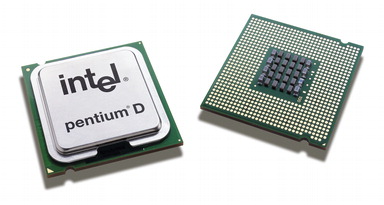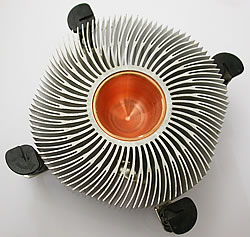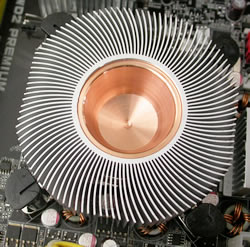Intel D 840 Dual Core CPU
1. Introduction

![]() In our last review concerning Intel's CPUs, we had tested the flagship Single-core processor from Intel, the 3.73GHz Extreme Edition which was also extremely expensive. This time, we have in our hands the 840 which is a Dual-Core CPU, running at 3.20GHz with 1MB L2 cache. Dual-Core processors are the new generation of CPUs and both Intel and AMD have already released not one, but over three different models.
In our last review concerning Intel's CPUs, we had tested the flagship Single-core processor from Intel, the 3.73GHz Extreme Edition which was also extremely expensive. This time, we have in our hands the 840 which is a Dual-Core CPU, running at 3.20GHz with 1MB L2 cache. Dual-Core processors are the new generation of CPUs and both Intel and AMD have already released not one, but over three different models.

The one we will review here costs approximately half the money of the P4 3.73GHz Extreme Edition and it is rather interesting to compare their performance. When you are about to get a new processor, most times, money will define which one is the most appropriate for your needs, otherwise we would all purchase the most expensive, thinking that we have also got the best. Is this true however?
| Architecture | 90 nm technology |
| L2 Cache | 2x1MB |
| Clock Speed | 3.20 GHz |
| Front Side Bus | 800 MHz |
| Chipset | - Intel 955X Express chipset - Intel 945P Express chipset - Intel 945G Express chipset - Intel E7230 Chipset |
| Socket | LGA775 |
 |
| Retail Package |
- Dual-Core: Provides two execution cores in one physical processor allowing the platform to do more in less time while enjoying smooth interaction with your PC.
- Enhanced Intel® SpeedStep® Technology: Available with the 840 and 830 processors, Enhanced Intel Speedstep Technology allows the system to dynamically adjust processor voltage and core frequency, which can result in decreased average power consumption and decreased average heat production. By decreasing power and heat on Desktop PCs, system builders can (depending on system configurations) potentially lower acoustics, and even develop more innovative small form factor designs. Additionally, this feature may help address power concerns in companies with sites approaching the limits of bounded electrical infrastructures. Combined with existing power saving features, Enhanced Intel SpeedStep technology may provide an excellent balance between providing power when you need it and conserving it when you don’t.
- Execute Disable Bit: This feature, combined with a supported operating system, allows memory to be marked as executable or non-executable. If code attempts to run in non-executable memory the processor raises an error to the operating system.
- Intel® Extended Memory 64 Technology: Intel EM64T provides an enhancement to Intel’s 32-bit architecture by enabling the desktop processor platform to access larger amounts of memory. With appropriate 64-bit supporting hardware and software, platforms based on an Intel processor supporting Intel EM64T can enable use of extended virtual and physical memory.
- 90nm Process Technology: The 90nm process technology is the latest in Intel manufacturing and technology leadership allowing for next generation transistor advantages, such as strained silicon lattice to deliver faster transistors and potentially increased performance.
- Level 1 Cache: The Pentium D processor features two 16KB data caches. In addition to the data cache, each core includes an Execution Trace Cache that stores up to 12 K decoded micro-ops in the order of program execution. This can increase performance by removing the decoder from the main execution loop and makes more efficient usage of the cache storage space since instructions that are branched around are not stored.
- 2MB Level 2 Cache: The Intel Pentium D processor based upon Intel 90nm process technology has a 1MB L2 Advanced Transfer Cache for each core (2MB total) improving overall system performance by allowing each processor core to have faster access to larger amounts of the most often used data.
- Streaming SIMD Extensions 3 (SSE3): Single Instruction Multiple Data Extensions significantly accelerates performance of digital media applications and includes additional integer and cache ability instructions that may improve other aspects of performance.
Processor Features & Definitions |
|
| Architecture | Basic design of a microprocessor. May include process technology and/or other architectural enhancements. |
| Cache (MB/KB) | A temporary storage area for frequently accessed or recently accessed data. Having certain data stored in a cache speeds up the operation of the computer. Cache size is measured in megabytes (MB) or kilobytes (KB). |
| Clock Speed (GHz/MHz) | Speed of the processor's internal clock, which dictates how fast the processor can process data. Clock speed is usually measured in GHz (gigahertz, or billions of pulses per second). |
| Front Side Bus (GHz/MHz) | The connecting path between the processor and other key components such as the memory controller hub. FSB speed is measured in GHz or MHz. |
The stock cooler that Intel includes in its retail version for the D 840 resembles the one used for the P4 series of processors. If you look more carefully however, you'll notice that there are some distinctive differences. The copper base, which exists in all of Intel's stock coolers, is more voluminous. The fins are also of a different design. This indicates that the heat dissipation required is going to be much greater than in single-core processors. This is something we will check on later.
 |
| Old cooler |
 |
| New Cooler |





















